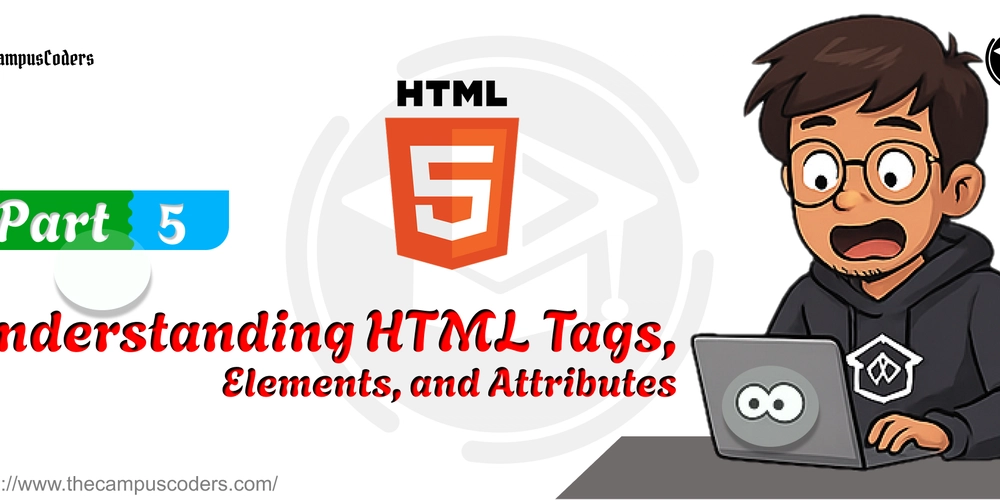Understanding HTML Tags, Elements, and Attributes
Introduction If you ever opened an HTML file and saw angle brackets < > everywhere, you’ve already seen HTML tags. But, tags alone don't build websites — it’s the combination of tags, elements, and attributes that shapes a fully functional web page. Before diving deeper into HTML development, you need a crystal-clear understanding of: What are Tags? What are Elements? What are Attributes? These concepts form the language of HTML — and mastering them will make everything else in web development much easier. 1. What is an HTML Tag? Definition: An HTML tag is a keyword surrounded by angle brackets < >, which tells the browser how to display or structure content. Syntax Example: This is a paragraph. is an opening tag. is a closing tag. Important Notes: Most tags come in pairs (opening and closing). Some tags are self-closing (more on that later). Think of a tag as a label you put on content — like tagging a box as "Fragile" or "Electronics" to indicate how it should be handled. 2. What is an HTML Element? Definition: An HTML element is everything from the start tag to the end tag, including the content between them. Example: Welcome to My Website Here: = Opening tag Welcome to My Website = Content = Closing tag Together, this entire structure is called an HTML Element. Visual Breakdown: Part Description Opening tag Welcome... Content Closing tag Element Combination of all above Key Takeaway: While tags describe what something is, elements are the complete units of meaning. 3. What are HTML Attributes? Definition: An attribute provides additional information about an HTML element. It modifies or clarifies the behavior or appearance of the element. Syntax: Content Example: Visit The Campus Coders = Anchor tag (used for links) href="https://thecampuscoders.com" = Attribute "https://thecampuscoders.com" = Value assigned to the href attribute Visit The Campus Coders = Link text Commonly Used Attributes: Attribute Purpose href Specifies the URL for a link src Specifies the path for an image () alt Alternative text for images (important for SEO) id Unique identifier for an element class Defines CSS class(es) style Adds inline CSS styling title Tooltip text on hover target Specifies where to open the linked document Best Practice: Always write attributes in lowercase, and always enclose values inside double quotes (" ").

Introduction
If you ever opened an HTML file and saw angle brackets < > everywhere, you’ve already seen HTML tags.
But, tags alone don't build websites — it’s the combination of tags, elements, and attributes that shapes a fully functional web page.
Before diving deeper into HTML development, you need a crystal-clear understanding of:
- What are Tags?
- What are Elements?
- What are Attributes?
These concepts form the language of HTML — and mastering them will make everything else in web development much easier.
1. What is an HTML Tag?
Definition:
An HTML tag is a keyword surrounded by angle brackets < >, which tells the browser how to display or structure content.
Syntax Example:
This is a paragraph.
-
is an opening tag. -
is a closing tag.
Important Notes:
- Most tags come in pairs (opening and closing).
- Some tags are self-closing (more on that later).
Think of a tag as a label you put on content — like tagging a box as "Fragile" or "Electronics" to indicate how it should be handled.
2. What is an HTML Element?
Definition:
An HTML element is everything from the start tag to the end tag, including the content between them.
Example:
Welcome to My Website
Here:
-
= Opening tag -
Welcome to My Website= Content -
= Closing tag
Together, this entire structure is called an HTML Element.
Visual Breakdown:
| Part | Description |
|---|---|
|
Opening tag |
Welcome... |
Content |
|
Closing tag |
| Element | Combination of all above |
Key Takeaway:
While tags describe what something is, elements are the complete units of meaning.
3. What are HTML Attributes?
Definition:
An attribute provides additional information about an HTML element.
It modifies or clarifies the behavior or appearance of the element.
Syntax:
attribute="value">Content
Example:
href="https://thecampuscoders.com">Visit The Campus Coders
-
= Anchor tag (used for links) -
href="https://thecampuscoders.com"= Attribute -
"https://thecampuscoders.com"= Value assigned to thehrefattribute -
Visit The Campus Coders= Link text
Commonly Used Attributes:
| Attribute | Purpose |
|---|---|
href |
Specifies the URL for a link |
src |
Specifies the path for an image ( |
alt |
Alternative text for images (important for SEO) |
id |
Unique identifier for an element |
class |
Defines CSS class(es) |
style |
Adds inline CSS styling |
title |
Tooltip text on hover |
target |
Specifies where to open the linked document |
Best Practice:
Always write attributes in lowercase, and always enclose values inside double quotes (" ").








































































































































































![[The AI Show Episode 144]: ChatGPT’s New Memory, Shopify CEO’s Leaked “AI First” Memo, Google Cloud Next Releases, o3 and o4-mini Coming Soon & Llama 4’s Rocky Launch](https://www.marketingaiinstitute.com/hubfs/ep%20144%20cover.png)


































































































































![[DEALS] The All-in-One Microsoft Office Pro 2019 for Windows: Lifetime License + Windows 11 Pro Bundle (89% off) & Other Deals Up To 98% Off](https://www.javacodegeeks.com/wp-content/uploads/2012/12/jcg-logo.jpg)















































































































































_Andreas_Prott_Alamy.jpg?width=1280&auto=webp&quality=80&disable=upscale#)


































































































![What features do you get with Gemini Advanced? [April 2025]](https://i0.wp.com/9to5google.com/wp-content/uploads/sites/4/2024/02/gemini-advanced-cover.jpg?resize=1200%2C628&quality=82&strip=all&ssl=1)












![Apple Shares Official Trailer for 'Long Way Home' Starring Ewan McGregor and Charley Boorman [Video]](https://www.iclarified.com/images/news/97069/97069/97069-640.jpg)
![Apple Watch Series 10 Back On Sale for $299! [Lowest Price Ever]](https://www.iclarified.com/images/news/96657/96657/96657-640.jpg)
![EU Postpones Apple App Store Fines Amid Tariff Negotiations [Report]](https://www.iclarified.com/images/news/97068/97068/97068-640.jpg)




























![Mobile Legends: Bang Bang [MLBB] Free Redeem Codes April 2025](https://www.talkandroid.com/wp-content/uploads/2024/07/Screenshot_20240704-093036_Mobile-Legends-Bang-Bang.jpg)







































































































